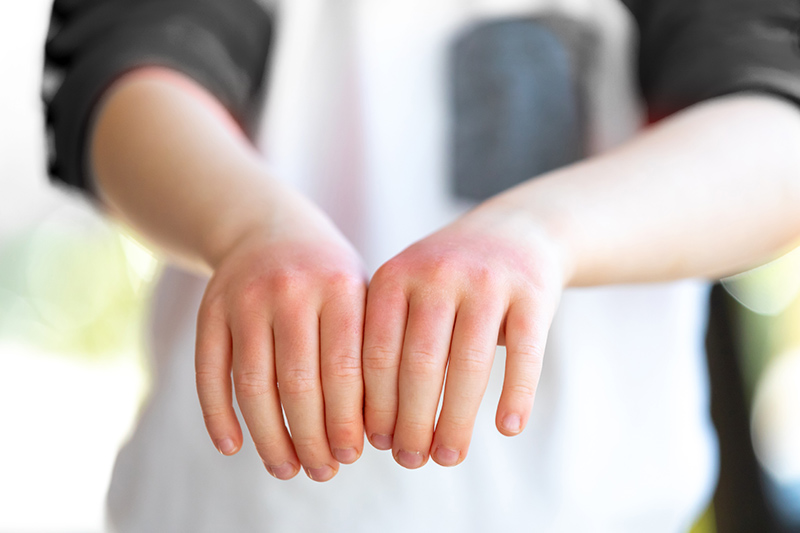Contact dermatitis is a common disease that often occurs already in adolescence. But how does contact dermatitis occur, what role does the skin barrier play, and how can contact dermatitis influence your ability to work and quality of life?
This article is based on an interview with Professor of Dermatology, Torkil Menné.
Contact dermatitis is a common disease that often occurs already in adolescence. Over the course of a year, approx. 10% of the Danish population will experience contact dermatitis on their hands – also called hand eczema or hand dermatitis. For a smaller proportion of these, contact dermatitis leads to chronic skin changes on their hands, affecting their ability to work and their quality of life. Contact dermatitis is also common on the face, where some people experience allergies to cosmetic products.
There are two types of contact dermatitis: Irritant contact dermatitis, where dermatitis occurs because the skin has been exposed to irritants, and allergic contact dermatitis, in which dermatitis occurs because the skin has been in contact with substances to which one is allergic. It is not uncommon for contact dermatitis to have both an irritant and an allergic effect on the skin. Deodorants, for example, can cause irritant dermatitis in the armpit while also containing allergenic fragrance chemicals that cause allergic dermatitis.
How irritant contact dermatitis occurs
The risk of developing irritant contact dermatitis is greater if you have the underlying skin disease known as atopic dermatitis (also called atopic eczema) and a possible underlying mutation in the filaggrin gene.
Irritant contact dermatitis typically occurs because the skin has been subjected to prolonged exposure to water, tight-fitting rubber gloves, soaps, oils or fresh foodstuffs, which have damaged the skin’s barrier function. Contact dermatitis on the hands is the most frequently reported occupational dermatitis in Denmark. Approximately 40% of the Danish population work in the so-called wet occupations – i.e. professions where the hands are in frequent contact with water. For example, hairdressers, butchers, healthcare professionals, cleaning assistants or dishwashers. Anyone who works in these so-called wet occupations should apply a cream that prevents dehydration of the skin and increases the water-binding capacity of the outermost skin layers.

How allergic contact dermatitis occurs
Allergic contact dermatitis occurs if you have developed an allergy to chemicals and naturally occurring substances that are found in your immediate environment. For example, metals such as nickel, fragrances, preservatives, rubber gloves or fresh foods. The list of things that can cause contact allergy is long and includes over 3,000 substances. If you suspect that you have developed a contact allergy, a dermatologist can perform an allergy test to find out which substances you are allergic to.
Contact allergy is a lifelong condition
If you have developed a contact allergy, it is a lifelong condition, and the contact allergy worsens each time you are exposed to the substance you have become allergic to. The contact allergy affects the entire surface of the skin – so if, for example, you become allergic to nickel due to having pierced earlobes, you will have a lifelong nickel allergy all over your body. There is no treatment for the allergy itself, only for the dermatitis.
Differences in progression and treatment
There are significant differences between irritant contact dermatitis and allergic contact dermatitis, both in terms of how the dermatitis develops and how it should be treated.
Irritant contact dermatitis typically starts with dry skin, which occurs because of damage to the skin barrier. The earliest signs of irritant contact dermatitis on the hands are dryness and scaling in the interdigital spaces. If you cannot halt these skin changes by using a moisturizer, you should consult your doctor.
Allergic contact dermatitis, on the other hand, starts within a few weeks with itching, redness and possible blistering. Allergic contact dermatitis is, thus, more acute and may have more severe symptoms. In allergic contact dermatitis, the inflammation itself starts deep in the skin, but the inflammation spreads and causes damage to the skin barrier, so that the normal functioning of the barrier is destroyed.
Allergic contact dermatitis is treated with prescription drugs of the steroid hormone type. It is important that exposure to the identified allergens has stopped. Once the acute phase is over, it is important to rebuild the skin barrier with water-binding creams that are also able to restore the skin’s normal pH value.
Would you like to learn more?
For more information about irritant contact dermatitis and allergic contact dermatitis, you can delve into the articles listed as references below.
References
-
Videncenterforallergi.dk
-
Coenraads PJ. Hand eczema. N Engl J Med. 2012 Nov 8;367(19):1829-37
-
Fortino V, Wisgrill L, Werner P, Suomela S, Linder N, Jalonen E, Suomalainen A, Marwah V, Kero M, Pesonen M, Lundin J, Lauerma A, Aalto-Korte K, Greco D, Alenius H, Fyhrquist N. Machine-learning-driven biomarker discovery for the discrimination between allergic and irritant contact dermatitis. Proc Natl Acad Sci U S A. 2020 Dec 29;117(52):33474-33485
